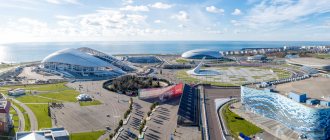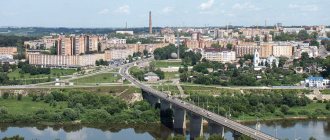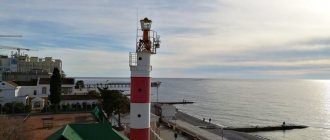All districts in the Saratov region with a map are here: Districts of the Saratov region The official website of the city of Atkarsk is here. In Russia there are many large and small cities that are located apart from popular tourist routes, and therefore are undeservedly forgotten. But it is precisely such cities that, as a rule, are of particular interest. And they are also worth visiting to be periodically reminded of how beautiful our country is and how much interesting things there are in it.
Atkarsk is located in the Saratov region, in the Volga Upland zone, where the two rivers Atkara and Medveditsa unite; it is located 92 kilometers from the center of the region. The area of the immediate settlement is 10.5 kilometers. The city was founded at the end of the eighteenth century, and for a long time was afloat thanks to the grain trade.
In the next century, a fire destroyed most of the city. The city was rather unsettled and gray before the fire, but now it has acquired a special homeliness. They began to call it Straw Town.
How to get there?
To get to this town you can take the Moscow-Saratov train, which stops right in Atkarsk. Other trains of different directions also pass here, for example to Almaty or Astrakhan.
General information and historical facts
The area is part of the historical Great Steppe. For a long time, this area was inhabited by nomadic peoples. Sarmatians, Khazars, and Polovtsians once lived here. In 1358, on the site of today's city there was an ulus of the Tatar Khan Etkara. In 1699, thanks to the order of Peter 1, a settlement was formed in this area, which was subordinate to the Petrovsky governor.
Almost 90 years later, when Catherine II was in power, the settlement turned into a county town with the name Atkarsk. By the beginning of the 19th century, the number of inhabitants was 1,200 people. In 1870 there was a big fire, during which most of all the buildings of the city disappeared. Two years later, the Tambov-Saratov railway line was put into operation, which in the future had a great influence on the rapid prosperity of the city.
By 1907, the population was already more than 13 thousand people. At the beginning of the 20th century, the settlement could already boast of a couple of steam engines, a couple of mills, and a locomotive depot. There were four brick factories, one soap factory, a couple of grain mills and several other enterprises located here. In 1928, Atkarsk was declared the center of the Atkarsky district of the Saratov region, in the Lower Volga region.
In the 1960s, multi-storey buildings appeared in the area, in the form of residential buildings and kindergartens. A clinic, a cinema and other social and administrative buildings began to function.
The modern city has a machine-building plant and a couple of metalworking factories, a furniture factory, a couple of clothing factories, and several processing organizations.
To make calls to the city you will need to dial the area code “84552”. And to send letters, you should remember the postal code “412420”.
Top 10 most interesting facts about the monuments of the city of Atkarsk. Part 1
In Atkarsk there are currently several dozen monuments, steles and busts, most of them are dedicated to specific historical figures and events, but there are also abstract figures - for example, the composition of the First Teacher.
The publication “Atkarsky Uyezd” tried to collect the most interesting facts about local monuments, and there were a lot of them. Perhaps they will surprise someone and will certainly be curious.
Fact 1. Before the revolution, there was not a single monument in Atkarsk; at least, we did not find not only photographic evidence and evidence to the contrary, but also any written evidence.
Fact 2. The very first Atkar monument can be considered a wooden tombstone with a five-pointed star installed on Torgovaya Square at the burial site of soldiers and communists who died in 1919-1921 in clashes with Popov’s troops. The installation of the first Atkar monument was proposed by the “All-Union Elder” Mikhail Kalinin, who visited our city. Atkarchans will subsequently erect a monument to Kalinin himself. Exactly 80 years ago, in 1937, the stele was replaced with a stone one.
Fact 3. Exactly 50 years ago, for the anniversary of the October Revolution, the above-mentioned stele was replaced with a sculptural composition of a Soldier, a Commissar and a Sailor. Few people know that at the same time, a handful of earth from the mass grave of soldiers who died during the Great Patriotic War was delivered from old cemeteries by military hearse. Thus, this monument became the heroes of not only the Civil War, but also the war of 1941-1945. That is why the Eternal Flame was lit here then.
Fact 4. The above-mentioned monument suffered at the hands of vandals in 1995 (specifically the figure of the commissioner suffered), even earlier it began to seriously deteriorate over time and was subsequently replaced.
Fact 5. Exactly 80 years ago in the city of Atkarsk, a bust of Alexander Sergeevich Pushkin was erected; it was located not far from the modern Memorial of Glory in the city park (as we talked about in the material about interesting street names, the park was also named after A. S. Pushkin in 1937 ).
The monument to the poet was surrounded by massive metal chains, and the famous quatrain “Comrade, believe, she will rise...” was engraved on the one and a half meter pedestal. Due to the construction of the memorial, it was decided to move the monument to Pushkin; it was installed on Sovetskaya Street in a symbolic place, next to the “Books” store, where it remains to this day, although the bookstore has been gone for a long time.
- < Back
- Forward >
atkarskuezd.ru
Attractions and entertainment
After the fire, the city was actively developed: stone and brick buildings appeared. And since the peak of the city’s heyday as a commercial city began along with active construction, the result turned out to be excellent. Visitors immediately note that the railway station building itself has cheerful colors and elements in the neoclassical style. After this, I want to examine in detail the architectural features of the city. Let's get to know what interesting things there are in the city and why it is attractive. The House of Culture is a monument of constructivism. The city administration is externally designed in a rare neo-Russian style, which was very fashionable at the beginning of the 20th century. Women's gymnasium - formerly it was an executive committee, then a school with a technical school. During the war, a military hospital was located here, and then captured Germans were brought here. Now it houses a boarding school.
The city has many buildings made of neatly laid red bricks. There are buildings with towers, projections, balconies, and architraves. They are in fair condition and are not subject to modern restoration. The historical center has many such buildings that create the appearance of comfort, creating the impression of a good prosperous city, as it was many years ago. There are almost no tall buildings here, which makes it possible to fully perceive all the monuments in the right atmosphere. The zoo, which is already more than fourteen years old, is the real pride of the city. There are not many animals here, but they are all of interest to both locals and tourists. There are wolves, and deer, and bears, and wild boars. Among the small pets there are rabbits and nutria. Entertainment in the form of attractions has been built for children.
Arboretum and nursery of ornamental crops. Those who love nature, and especially lilacs, should definitely visit this place. After all, a unique collection of lilacs and its different types is presented here. The formation of an arboretum has become an urgent need, since greenery in this area is needed to stop soil erosion. There are also exotic plants here. Their research focuses on local adaptation. The trees that grew here were once planted near the Moscow Kremlin.
Marfinskaya park area is an oasis of coniferous forest near the steppe zone. The peculiarity of the park is that it contains trees that are not accustomed to this climate, for example, larch, fir and spruce. Like any decent park, it has its own radial planning system. To create such a unique composition, great effort and expense had to be made, since during drought there is artificial watering through irrigation channels.
The BMP.1 combat vehicle is a memorial opened nearby seven years ago. Cinema - the first building was erected by chief machinist Kapustin back in 1904. The fairytale carriage is an art object that looks like a sculpture of a unicorn and a carriage, installed in Atkarsk a year and a half ago. A local history museum that is worth visiting for anyone who is not yet familiar with the history of the city, this area and knows nothing about the development of industry here. Central Park - it is constantly maintained. It contains a monument to the famous commander Rokossovsky, as well as Marshal Zhukov. A bust of J.V. Stalin was erected on one of the alleys.
In the center there are many buildings built at the end of the 19th century. They are architectural monuments, unique and interesting objects from a historical point of view.
In the center there is an old building in which noble meetings were held for a long time. There was a library in the school building at that time.
Golden ring of Atkarsky district. Part one
On August 5, 2022, in the company of Scandinavian Sergei and Alena, we gathered in Atkarsk for the Atkar Roses festival. But traditionally this year, we got together late: some overslept, some forgot something, and, in the end, we started after lunch, deciding not to rush. If we have time, it’s good, if we don’t have time, it’s too bad... okay. The main goal of the trip is to cover several more points of the future route “Golden Ring of Atkarsky District”.
Field roads, Ozernoye village on the horizon:
The first point was just a mark on the map, no photos, no information - Zemlyachesky Oak:
Medveditsa River:
Hot. Whoever is more cunning immediately hides in the shadows 
Well, in general, oak is like oak. Only big. And there is a lot of garbage, due to the proximity of the settlement...
And we're going for a swim! We cross the Bear, the wooden supports of the old bridge are still visible in the water:
We stopped at the beach near Staraya Lopukhovka and went swimming:
In the heat, water treatments are just the thing!
Old Lopukhovka. Monument to the Mothers of the Great Patriotic War:
Church of St. Nicholas the Wonderworker:
The village of Lopukhovka was founded no later than the second half of the 18th century near the Medveditsa and Itkarka rivers. After the throne of the local church, built in 1817, the village was also called Nikolskoye. The stone building, with a stone bell tower, was built with the care of the landowner Kineshsky. The chapel in the temple was consecrated in the name of the saints and righteous Simeon the God-Receiver and Anna the Prophetess. The last owner of the village was landowner Yuryevich. As part of the Atkarsky district of the Saratov province, Lopukhovka was a volost center.
During the Soviet years, the building of the Church of St. Nicholas the Wonderworker lost its bell tower and was used as a granary.
Between the villages of Belgaza and Staraya Lopukhovka there is a unique monument - a crypt with the ashes of the last landowner of Staraya Lopukhovka - A.S. Yurievich. In 1999, by order of the mayor of Atkarsk, it was decorated with a new memorial with a gazebo and an arch with a bell. A cross was placed over the burial and a slab with Yuryevich’s spiritual testament was restored: “Let the haves help the weak.” According to local residents, in the crypt there is a real stone coffin to which a staircase descends.
The crypt is located at the top of a hill, offering beautiful views of the nearby villages. Visibility in clear weather reaches 40 km.
The inscription on the gravestone reads: “Here lies the ashes of the servant of God, actual state councilor Alexander Semenovich Yuryevich.” Everything seems to be as it should be, if not for one circumstance: there has never been a cemetery here, this only burial is located on a hill literally in an open field! This is what the landowner himself bequeathed.
Acting State Councilor Alexander Semyonovich Yuryevich was born in 1853 and inherited from his father Semyon Alekseevich lands in Atkarsky district with an estate in Lopukhovka. Young Yuryevich moved to the estate with his family and actively took up its development, planting, in particular, a pine park and continuing his father’s favorite business - collecting a collection of art and antiquities. Alexander Semyonovich proved himself to be an excellent and zealous owner, under whom not only his own estate flourished, but also the peasants of Lopukhovka and surrounding villages lived better than others. This is confirmed by the revolutionary year 1905, the year of Yuryevich’s death. While the entire district was engulfed in pogroms and arson of lordly estates, in Lopukhovka the peasants not only did not touch the Yuryevich estate, but they themselves carried the coffin of the respected landowner in their arms to the burial place in a funeral procession. It was chosen in advance by Yuryevich himself, who wished in his will to be buried on a high hill, from which a view of all his lands and his beloved estate opens up.
Staro-Lopukhovsky Park, part of the Yuryevich estate:
It is located in the floodplain of Itkara, a tributary of the Medveditsa River, in a very picturesque area with slightly hilly terrain, revealing vast distances and floodplain forests along the Medveditsa. The park is a plantation of Scots pine. A linden alley has been preserved along one side of the park, where, apparently, there was an orchard adjacent to it, old specimens of fragrant poplar, very rare in the region at present, there are two types of hawthorn and thickets of black elderberry, growing only in this park.
Pine Alleys:
After a walk through Yuryevich's garden we went to Shcherbinovka. Ford across the Itkarka River:
Let's have fun 
Beautiful house in Shcherbinovka:
Mysterious red brick buildings in Shcherbinovka:
What it was and when it was built - no information could be found...
Ruins of a water tower built in 1914:
After Shcherbinovka we went to Prirechnoye. We wanted to photograph the rapids on the Medveditsa River, but it didn’t work out. In low water, the rapids are practically invisible, just small riffles. You should go in early May, then there are spectacular views...
Monument to the First Teacher in Prirechny:
The monument has a rather interesting history. If it weren't for the collapse of the Soviet Union, it might not have existed. The hometown of the author of the monument, Pavel Andreevich Yakushev, is Tashkent, where he worked as a graphic designer. Monument to the first teacher, created by P.A. Yakushev, stands in the village of Prirechnoye, Atkarsky district, where he moved from Tashkent.
Church in the name of Archangel Michael in Prirechny:
Probably the most famous landmark of the Atkarsky district is the wooden Church of the Archangel Michael in Novaya Osinovka:
Vanya is trying to fix the bell tower 
We are going to Atkarsk. Monument to the Streltsy - the founders of Atkarsk:
We were already hopelessly late for the Atkar Roses festival, so we just walked around the city park-museum:
True, we still saw roses:
Fire tower in Atkarsk:
On May 5, 2022, the central street of the city of Atkarsk was decorated with a new art object - a winged unicorn; its figure complemented the previously installed carriage near the shopping complex of the same name.
And we, of course, did not pass by 
The unicorn is shod, and the inscription on the horseshoe reads “I bring good luck”:
Nearby is another art object - a knight near the Ivanhoe restaurant:
We decided not to go to the points anymore, we need to get up to rest. At first we thought of going to the Shumok spring and settling there, then we changed our minds. We bought the necessary products in Atkarsk and went in search of a place to spend the night...
We camped in a beautiful clearing with crooked pine trees. The air was so clean that it seemed drinkable. We slept well and decided not to go anywhere else...
In the morning we went fishing on Medveditsa:
We even caught fish 
Some go fishing, and Vanya goes hunting 
They won't let you into the camp without loot. 
We had a wonderful time. And we will cover the following points of the route next time...
Route: Ozerki - Staraya Lopukhovka - Shcherbinovka - Prirechnoye - Novaya Osinovka - Atkarsk
asrmod.ru
Transport and trade
Atkarsk has a modern railway station that connects this place to Tatishchevo, Saratov, Ekaterinovka. The city has public transport in the form of buses and minibuses. From the city bus station there are constantly buses to Saratov, Rtishchevo, Ekaterinovka.
As already mentioned, the trade in bread, the main “gold” of the region, in distant years turned the Saratov province into one of the main centers of the Russian economy. A key role in the development of the city was played by its location between the main centers of grain trade, Saratov and Balashov. But the city has always stood apart from its neighbors, which were stronger in all respects.
At one time, the key event was the opening of a station in the Tambov-Saratov direction, as well as the creation of a branch to Volsk. Since that time, there has been an influx of specialists in various fields, from workers to artisans. With the advent of roads, the economic and geographical position has improved, the city has become a major point of grain trade.
All villages brought grain to the city, where merchants purchased it, and then sent it by train to the capital and other large cities. Every year, up to three million pounds of bread were brought here. Nowadays, the city is popular for the production of equipment for the mining and processing industry, as well as, as before, for the supply of agricultural products.
History paragraph
Atkarsk is surrounded by two rivers - Atkara and Medveditsa. The city was founded at the end of the 18th century and existed through the grain trade. In the 19th century, fire destroyed two-thirds of the city, which was so shabby and unsettled that it was called Straw Town.
Of course, this is already in the distant past. The opening of the Tambov-Saratov railway stirred up this sleepy town, and by the beginning of the revolution, workers, merchants, and artisans lived here. The importance of Atkarsk as a center of grain trade gradually increased. The revolution opened up new horizons for the city, including in industry. Until now, one of the main activities of the city is the production of equipment for the mining industry.
The Atkar Arboretum was founded before the revolution and is rightfully famous not only in the Saratov region, but throughout Russia.








